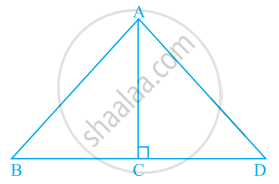Advertisements
Advertisements
प्रश्न
The area of a triangle with vertices A(3, 0), B(7, 0) and C(8, 4) is ______.
विकल्प
14
28
8
6
उत्तर
The area of a triangle with vertices A(3, 0), B(7, 0) and C(8, 4) is 8.
Explanation:
Vertices of the triangle are,
A(x1, y1) = (3, 0)
B(x2, y2) = (7, 0)
C(x3, y3) = (8, 4)
Area of triangle = `|1/2[x_1(y_2 - y_3) + x_2(y_3 - y_1) + x_3(y_1 - y_2)]|`
= `|1/2[3(0 - 4) + 7(4 - 0) + 8(0 - 0)]|`
= `|1/2[-12 + 28 + 0]|`
= `|1/2[16]|`
= 8
Therefore, the area of ΔABC is 8.
APPEARS IN
संबंधित प्रश्न
Find the area of a triangle with vertices at the point given in the following:
(1, 0), (6, 0), (4, 3)
Find equation of line joining (3, 1) and (9, 3) using determinant.
Find the area of a triangle whose vertices are
`(at_1^2,2at_1),(at_2^2,2at_2)` and `(at_3^2,2at_3)`
Prove that the points A(2, 4), b(2, 6) and (2 +`sqrt(3)` ,5) are the vertices of an equilateral triangle
For what values of k are the points A(8, 1) B(3, -2k) and C(k, -5) collinear.
Find the value(s) of p for which the points (3p + 1, p), (p + 2, p – 5) and (p + 1, –p) are collinear ?
The coordinates of the point P dividing the line segment joining the points A (1, 3) and B (4, 6) in the ratio 2 : 1 are:
If Δ = `|(1, x, x^2),(1, y, y^2),(1, z, z^2)|`, Δ1 = `|(1, 1, 1),(yz, zx, xy),(x, y, z)|`, then prove that ∆ + ∆1 = 0.
The area of the triangle ABC with the vertices A(-5, 7), B(-4, -5) and C(4, 5) is ______.
In the given figure, ratio of the area of triangle ABC to the area of triangle ACD is the same as the ratio of base BC of triangle ABC to the base CD of ΔACD.

